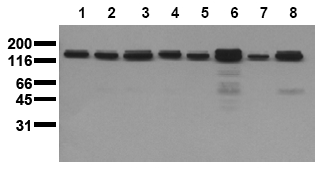MET (Activation Loop) (incl. pos. control) Mouse Monoclonal Antibody [Clone ID: 14G9]
CAT#: AM20218PU-N
MET (Activation Loop) (incl. pos. control) mouse monoclonal antibody, clone 14G9, Purified
Other products for "MET"
Specifications
| Product Data | |
| Clone Name | 14G9 |
| Applications | WB |
| Recommended Dilution | Immunoblotting: 0.5 µg/ml for HRPO/ECL detection. Recommended blocking buffer: Casein/Tween 20 based blocking and blot incubation buffer AS00002BU-N or AS00002BU-L. Included Positive Control: Cell lysate from untreated A431 cells (See Protocols for more details). |
| Reactivities | Human |
| Host | Mouse |
| Isotype | IgG1 |
| Clonality | Monoclonal |
| Immunogen | peptide conjugated to hemocyanin Epitope: kinase activation loop. |
| Specificity | This monoclonal MET antibody (14G9) recognizes Met activation loop. |
| Formulation | 1ml PBS, containing 0.09% Sodium Azide/PEG and Sucrose. State: Purified State: Lyophilized purified Ig fraction. |
| Reconstitution Method | Restore with 1 ml H2O (15 min, RT). |
| Purification | Subsequent Ultrafiltration and Size Exclusion Chromatography. |
| Storage | For long-term storage, freeze lyophilizate upon arrival (-20°C). Upon reconstitution, aliquote and freeze in liquid nitrogen; reconstituted antibody can be stored frozen at -80°C up to 1 year. Avoid repeated freeze / thaw cycles. Thaw aliquots at 37°C. Thawed aliquots may be stored at 2-8°C up to 3 months. |
| Gene Name | Homo sapiens MET proto-oncogene, receptor tyrosine kinase (MET), transcript variant 2 |
| Database Link | |
| Background | MET is a high affinity receptor for Hepatocyte Growth Factor/Scatter Factor HGF/SF. The (HGF/SF)-(HGFR/MET) ligand-receptor system appears to have an important role in controlling interaction between mesenchymal cells and other cell types and has been implicated in the cell mitogenic response, cell motility and development. The interaction with HGF leads to autophosphorylation at multiple tyrosine residues and recruiting of several downstream signaling components (Gab1, c-cbl, PI3-kinase). The phosphorylation of Tyr 1234/1235 leads to kinase activation, and phospho-Tyr 1349 is the Gab1 binding site. Altered MET levels and/or tyrosine kinase activities have been found in different tumors, such as colon, renal, and breast cancer. |
| Synonyms | Hepatocyte growth factor receptor, MET, Scatter factor receptor, HGF/SF receptor, c-Met |
| Note | Mol. weight: 145 kDa Protocol: Positive Control Provided. Cell lysate from untreated A431 cells Description: Cell lysate from untreated A431 cells, epidermoid carcinoma (Human) Format: Lyophilized cell lysate from serum starved A431 cells. Reconstitution:Restore by addition of 200 µl H20. After complete solubilization add 200 µl 2x SDS-PAGE sample buffer, mix and incubate at 90°C for 5 min. Storage: Aliquote and store frozen. Avoid repeated freeze/thaw cycles. Application: The positive control cell lysate is recommended for immunoblot applications. 20 µl of positive control cell lysate correspond to ca. 80.000 cells. Use 20 µl / lane (mini gel) for HRPO/ECL detection of the target proteins. Please note: The lyophilized cell lysates contain SDS and are not recommended for applications with native proteins such as immunoprecipitation. |
| Reference Data | |
| Protein Families | Druggable Genome, Protein Kinase, Transmembrane |
| Protein Pathways | Adherens junction, Axon guidance, Colorectal cancer, Cytokine-cytokine receptor interaction, Endocytosis, Epithelial cell signaling in Helicobacter pylori infection, Focal adhesion, Melanoma, Pathways in cancer, Renal cell carcinoma |
Documents
| Product Manuals |
| FAQs |
{0} Product Review(s)
0 Product Review(s)
Submit review
Be the first one to submit a review
Product Citations
*Delivery time may vary from web posted schedule. Occasional delays may occur due to unforeseen
complexities in the preparation of your product. International customers may expect an additional 1-2 weeks
in shipping.






























































































































































































































































 Germany
Germany
 Japan
Japan
 United Kingdom
United Kingdom
 China
China



